Crusader Plate Series from
Lancaster Commandery No. 2
Knights Templar
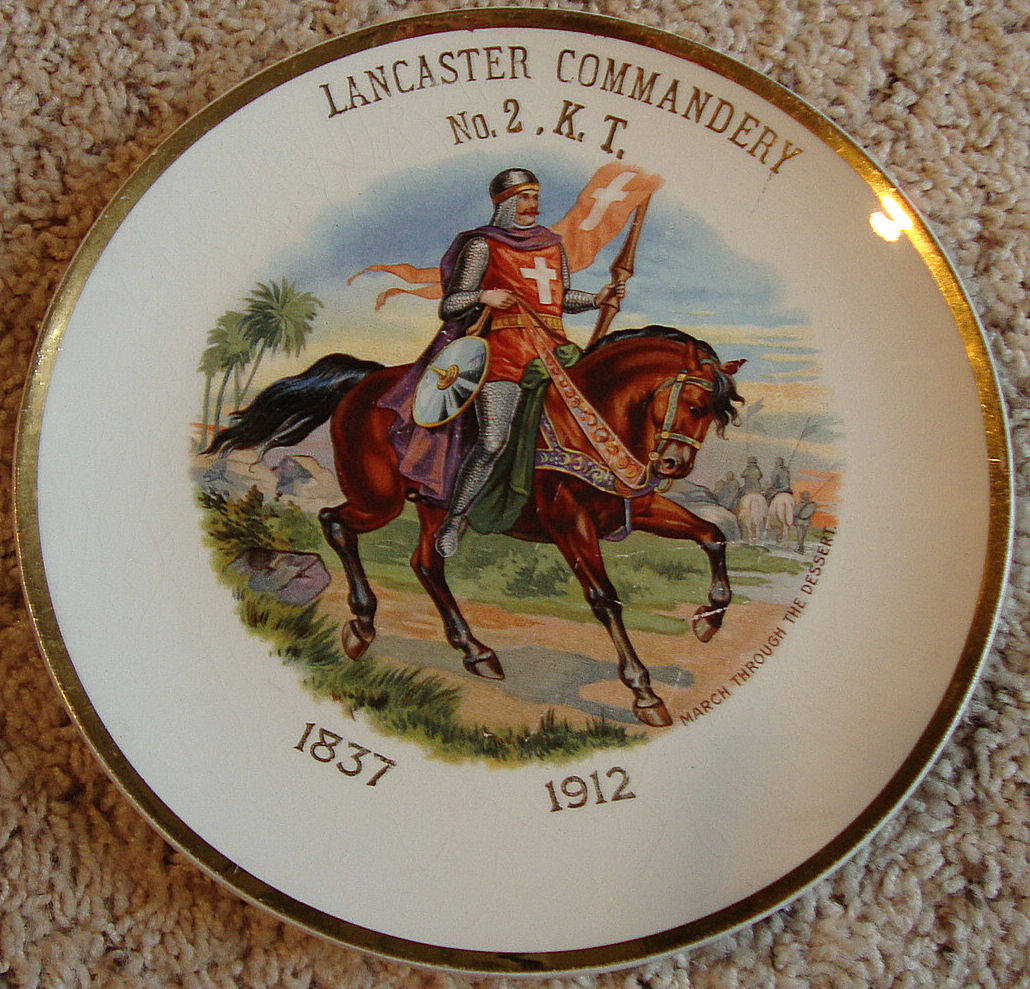
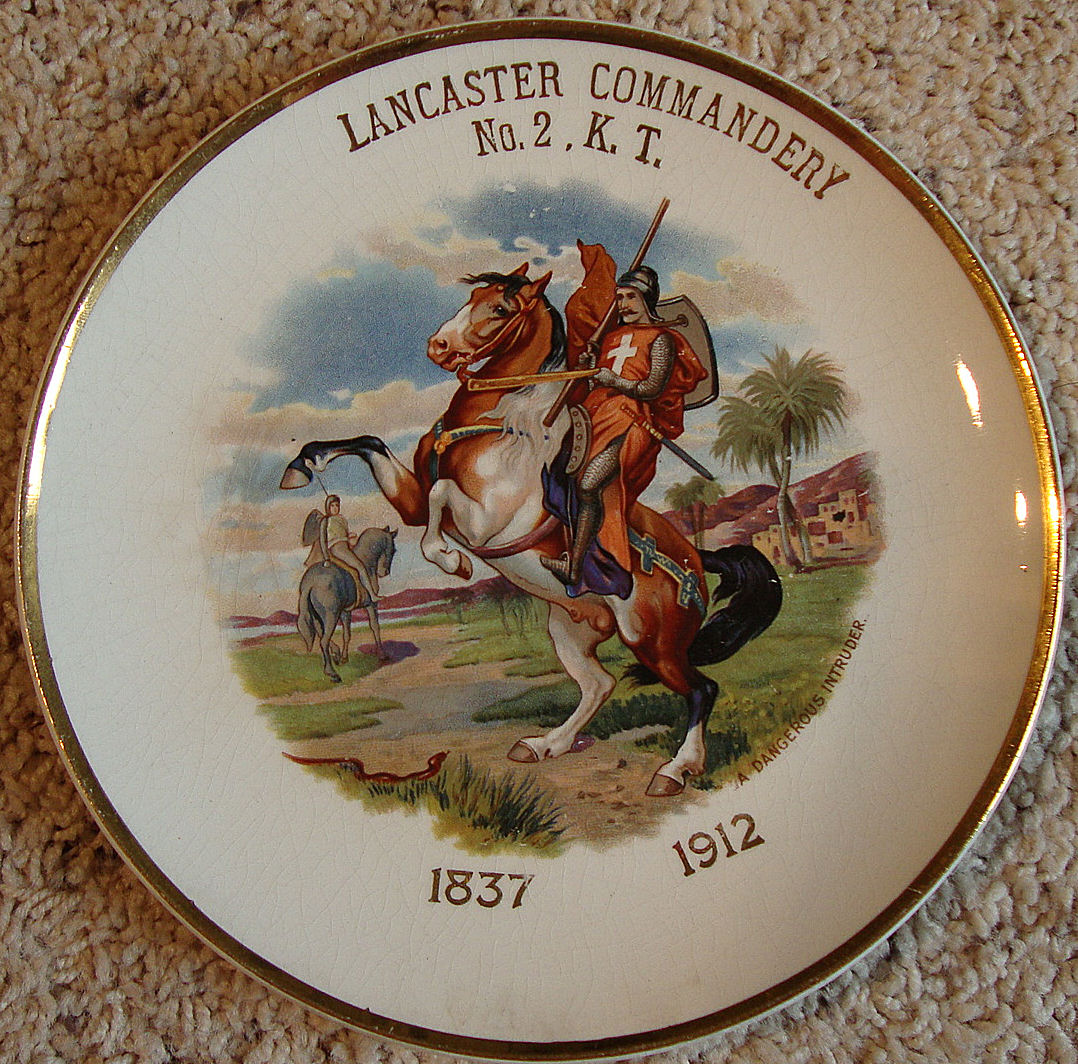
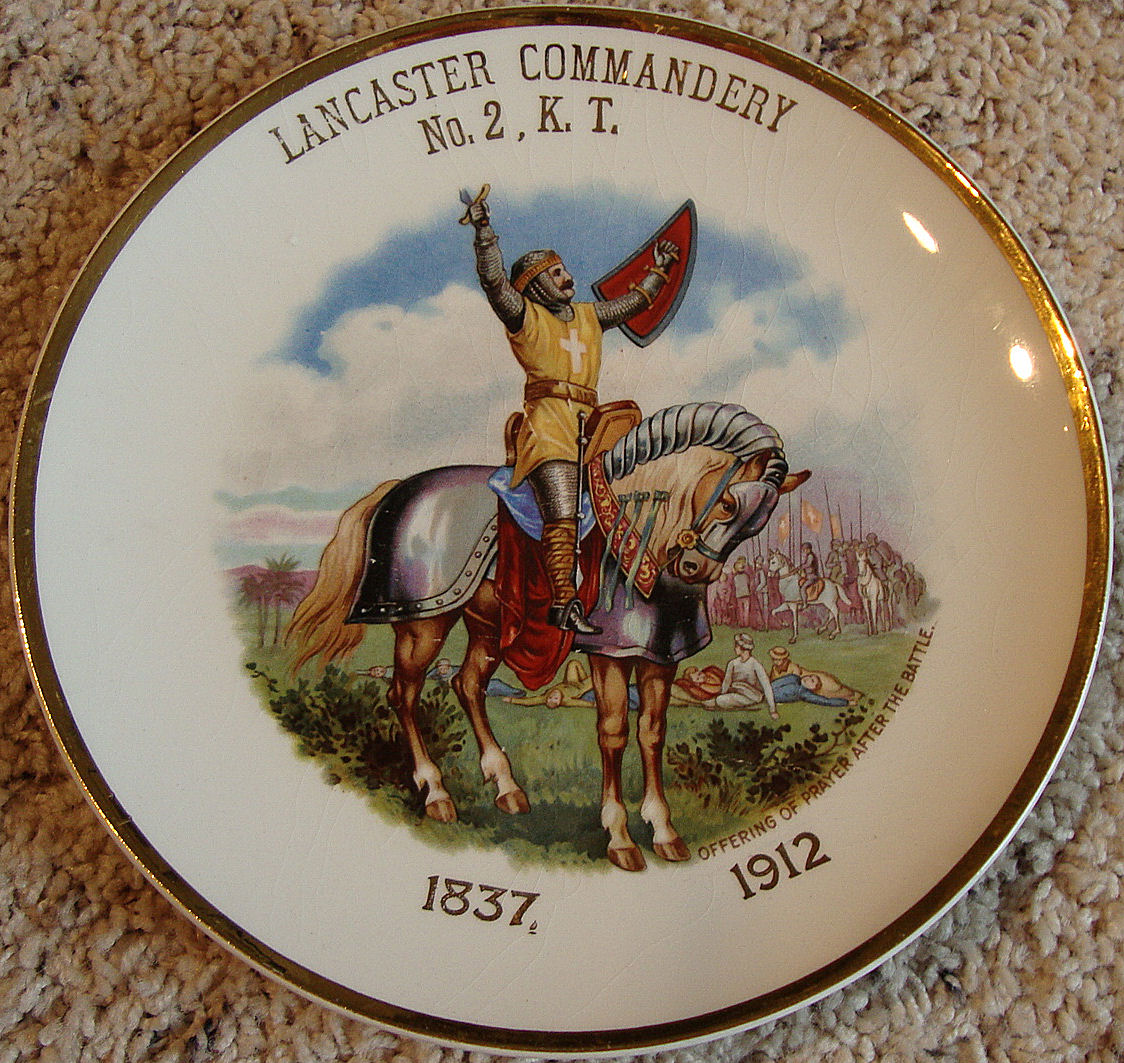
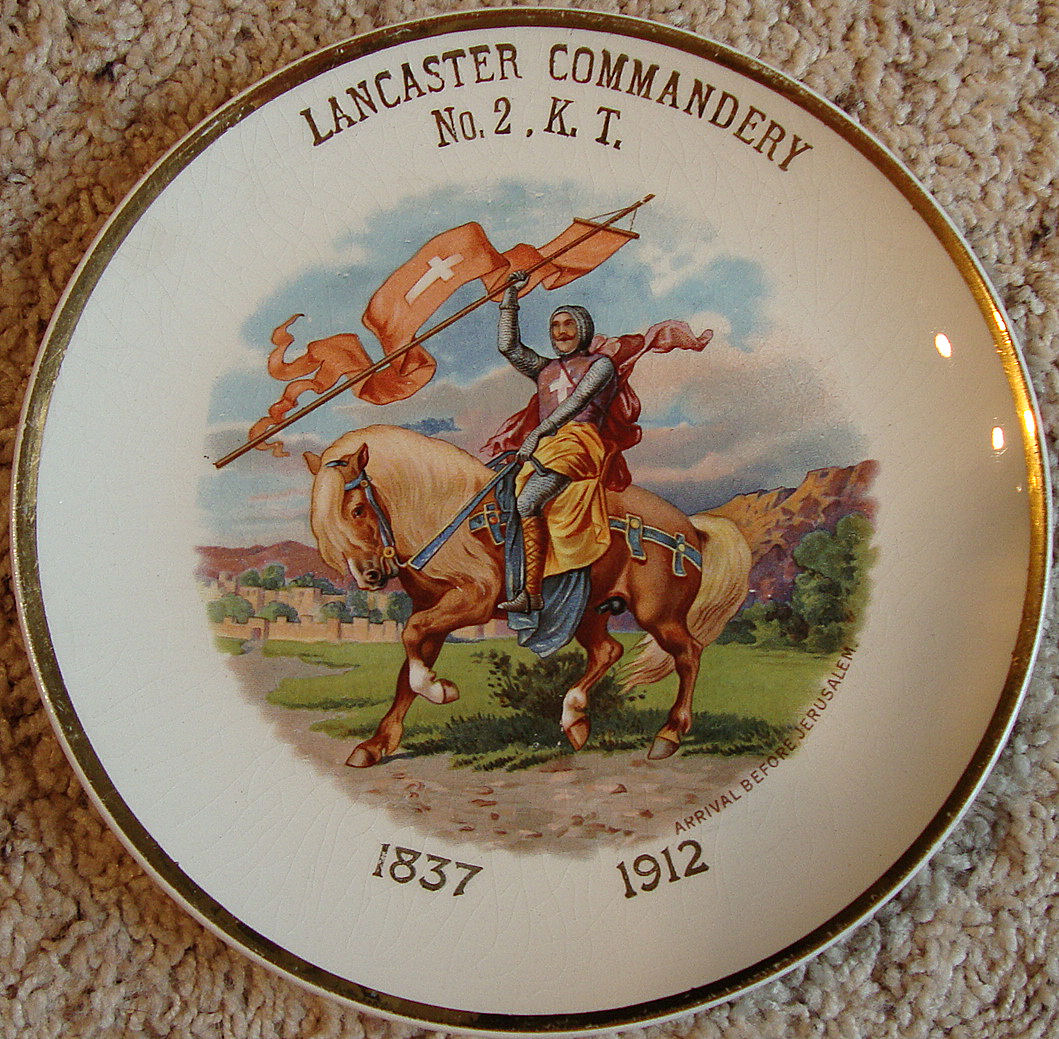
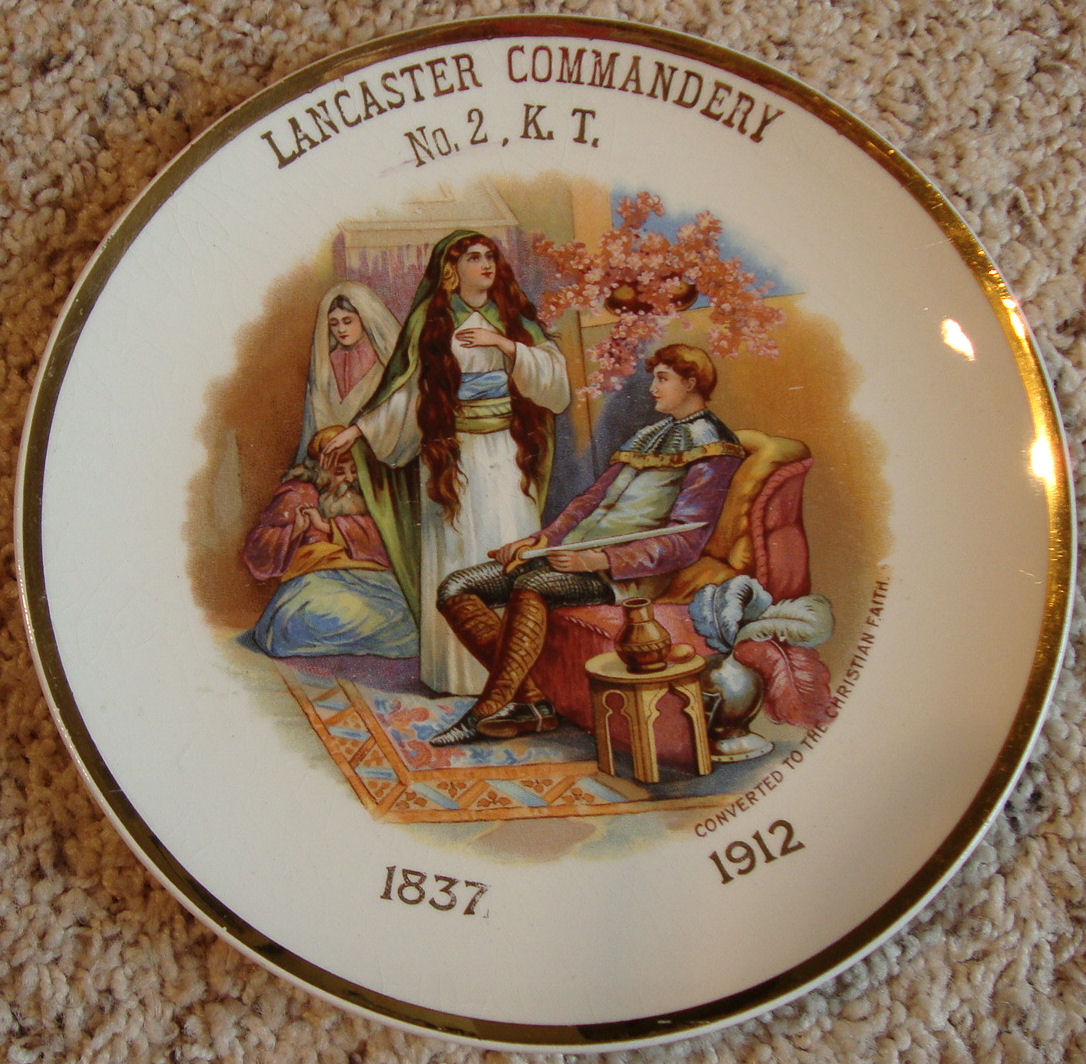
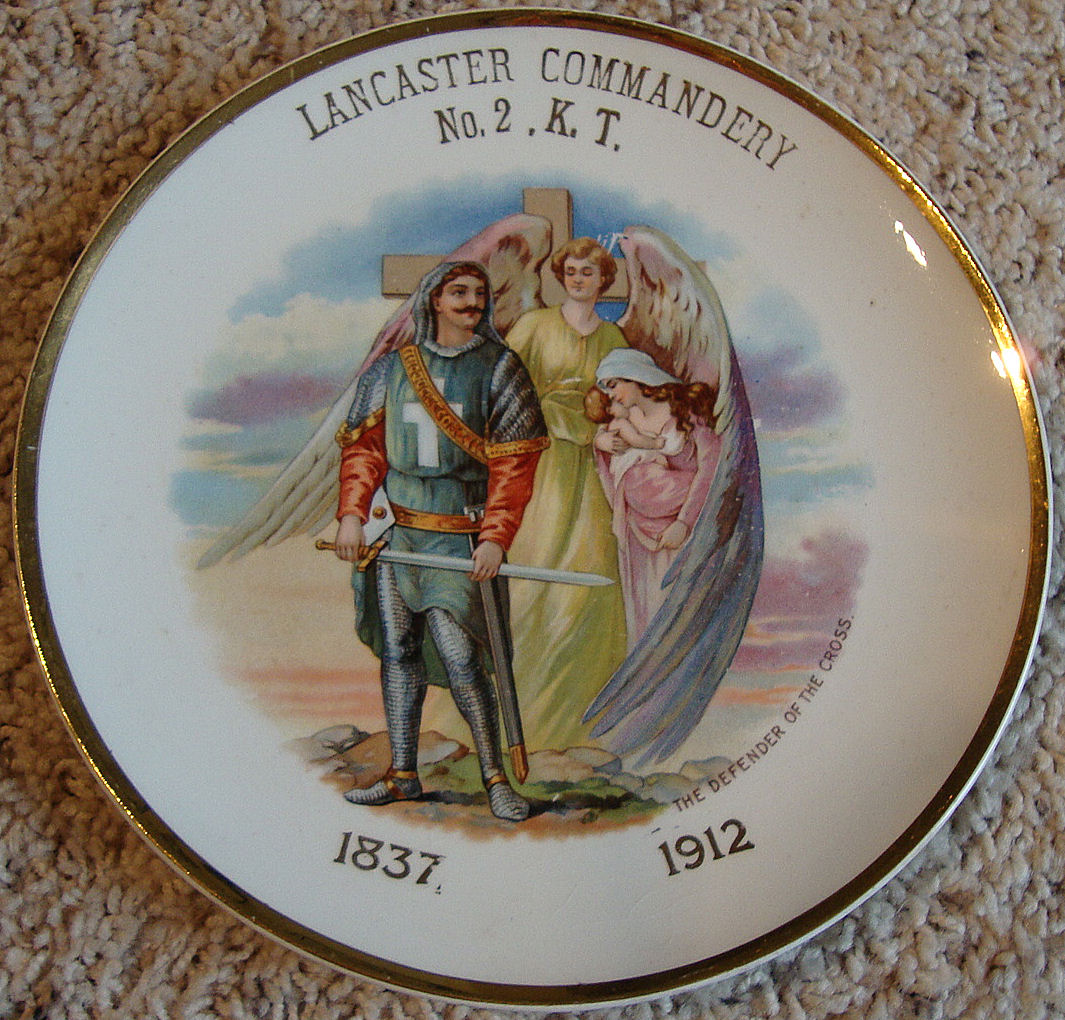
The Poor Fellow-Soldiers of
Christ and of the Temple of Solomon (Latin:
Pauperes commilitones Christi Templique
Salomonici), commonly known as the Knights Templar, the
Order of the Temple (French:
Ordre du Temple or Templiers)
or simply as Templars, were among the most famous of the
Western Christian
military orders.[4]
The organisation existed for nearly two centuries during the
Middle
Ages.
Officially endorsed by the
Catholic Church around 1129, the Order became a favoured charity throughout
Christendom and grew rapidly in membership and power. Templar knights, in their
distinctive white
mantles with a red
cross, were among the most skilled fighting units of the
Crusades.[5]
Non-combatant members of the Order managed a large economic infrastructure
throughout
Christendom, innovating financial techniques that were an early form of
banking,[6][7]
and building
fortifications across Europe and the
Holy Land.
The Templars' existence was tied
closely to the Crusades; when the Holy Land was lost, support for the Order
faded. Rumours about the Templars' secret initiation ceremony created mistrust
and King
Philip IV of France, deeply in debt to the Order, took advantage of the
situation. In 1307, many of the Order's members in France were arrested,
tortured into giving
false confessions, and then
burned at the stake.[8]
Under pressure from King Philip,
Pope Clement V disbanded the Order in 1312. The abrupt disappearance of a
major part of the European infrastructure gave rise to speculation and legends,
which have kept the "Templar" name alive into the modern day.
After the
First
Crusade recaptured
Jerusalem
in 1099, many
Christian
pilgrims travelled to visit what they referred to as the
Holy Places.
However, though the city of Jerusalem was under relatively secure control, the
rest of
Outremer was not. Bandits abounded, and pilgrims were routinely slaughtered,
sometimes by the hundreds, as they attempted to make the journey from the
coastline at Jaffa
into the Holy Land.[9]
Around 1119, the French knight
Hugues de Payens approached King
Baldwin II of Jerusalem with the proposal of creating a
monastic
order for the protection of these pilgrims. King Baldwin agreed to the request,
and granted space for a headquarters in a wing of the royal palace on the
Temple
Mount, in the captured
Al-Aqsa
Mosque. The Temple Mount had a mystique because it was above what was
believed to be the ruins of the
Temple of Solomon.[5][10]
The Crusaders therefore referred to the Al Aqsa Mosque as Solomon's Temple, and
it was from this location that the new Order took the name of Poor Knights of
Christ and the Temple of Solomon, or "Templar" knights. The Order, with
about nine knights including
Godfrey de Saint-Omer and
André de Montbard, had few financial resources and relied on donations to
survive. Their emblem was of two knights riding on a single horse, emphasising
the Order's poverty.[11]
The Templars' impoverished status did not last long. They had a powerful
advocate in Saint
Bernard of Clairvaux, a leading Church figure and a nephew of André de
Montbard, one of the founding knights. Bernard spoke and wrote persuasively on
their behalf and, in 1129, at the
Council of Troyes the Order was officially endorsed by the Church. With this
formal blessing, the Templars became a favoured charity throughout
Christendom, receiving money, land, businesses, and noble-born sons from
families who were eager to help with the fight in the
Holy Land.
Another major benefit came in 1139, when
Pope Innocent II's
papal bull
Omne Datum Optimum exempted the Order from obedience to local laws. This
ruling meant that the Templars could pass freely through all borders, were not
required to pay any taxes, and were exempt from all authority except that of the
pope.[13]
With its clear mission and ample resources, the Order grew rapidly. Templars
were often the advance force in key battles of the Crusades, as the heavily
armoured knights on their
warhorses would set out to
charge at the enemy, in an attempt to break opposition lines. One of their
most famous victories was in 1177 during the
Battle of Montgisard, where some 500 Templar knights helped several thousand
infantry to defeat
Saladin's
army of more than 26,000 soldiers.[14]
Although the primary mission of the Order was military, relatively few
members were combatants. The others acted in support positions to assist the
knights and to manage the financial infrastructure. The Templar Order, though
its members were sworn to individual poverty, was given control of wealth beyond
direct donations. A nobleman who was interested in participating in the Crusades
might place all his assets under Templar management while he was away.
Accumulating wealth in this manner throughout Christendom and the Outremer, the
Order in 1150 began generating
letters of credit for pilgrims journeying to the Holy Land: pilgrims
deposited their valuables with a local Templar preceptory before embarking,
received a document indicating the value of their deposit, then used that
document upon arrival in the Holy Land to retrieve their funds. This innovative
arrangement was an early form of
banking, and may have been the first formal system to support the use of
cheques; it
improved the safety of pilgrims by making them less attractive targets for
thieves, and also contributed to the Templar coffers.[5][15]
Based on this mix of donations and business dealing, the Templars established
financial networks across the whole of Christendom. They acquired large tracts
of land, both in Europe and the Middle East; they bought and managed farms and
vineyards; they built churches and castles; they were involved in manufacturing,
import and export; they had their own fleet of ships; and at one point they even
owned the entire island of
Cyprus. The
Order of the Knights Templar arguably qualifies as the world's first
multinational corporation.[14][16][17]
In the mid-12th century, the tide
began to turn in the Crusades. The
Muslim world
had become more united under effective leaders such as
Saladin, and
dissension arose among Christian factions in and concerning the Holy Land. The
Knights Templar were occasionally at odds with the two other Christian
military orders, the
Knights Hospitaller and the
Teutonic Knights, and decades of internecine feuds weakened Christian
positions, politically and militarily. After the Templars were involved in
several unsuccessful campaigns, including the pivotal
Battle of the Horns of Hattin,
Jerusalem
was captured by
Saladin's forces in 1187. The Crusaders retook the city in 1229, without
Templar aid, but held it only briefly. In 1244, the
Khwarezmi Turks recaptured Jerusalem, and the city did not return to Western
control until 1917 when the
British captured it from the
Ottoman Turks.[18]
The Templars were forced to
relocate their headquarters to other cities in the north, such as the seaport of
Acre,
which they held for the next century. But they lost that, too, in 1291, followed
by their last mainland strongholds,
Tortosa (Tartus
in what is now Syria),
and Atlit in
present-day Israel.
Their headquarters then moved to
Limassol on
the island of Cyprus,[19]
and they also attempted to maintain a garrison on tiny
Arwad Island, just off the coast from Tortosa. In 1300, there was some
attempt to engage in
coordinated military efforts with the Mongols[20]
via a new invasion force at
Arwad. In 1302 or
1303, however, the Templars lost the island to the Egyptian
Mamluks in the
Siege of Arwad. With the island gone, the Crusaders lost their last foothold
in the Holy Land.[14][21]
With the Order's military mission
now less important, support for the organisation began to dwindle. The situation
was complex though, as over the two hundred years of their existence, the
Templars had become a part of daily life throughout Christendom.[22]
The organisation's Templar Houses, hundreds of which were dotted throughout
Europe and the
Near East,
gave them a widespread presence at the local level.[3]
The Templars still managed many businesses, and many Europeans had daily contact
with the Templar network, such as by working at a Templar farm or vineyard, or
using the Order as a bank in which to store personal valuables. The Order was
still not subject to local government, making it everywhere a "state within a
state"—its
standing army, though it no longer had a well-defined mission, could pass
freely through all borders. This situation heightened tensions with some
European nobility, especially as the Templars were indicating an interest in
founding their own
monastic state, just as the
Teutonic Knights had done in
Prussia[15]
and the
Knights Hospitaller were doing with
Rhodes.[23]
In 1305, the new
Pope Clement V, based in France, sent letters to both the Templar Grand
Master
Jacques de Molay and the Hospitaller Grand Master
Fulk de Villaret to discuss the possibility of merging the two Orders.
Neither was amenable to the idea, but Pope Clement persisted, and in 1306 he
invited both Grand Masters to France to discuss the matter. De Molay arrived
first in early 1307, but de Villaret was delayed for several months. While
waiting, De Molay and Clement discussed charges that had been made two years
prior by an ousted Templar. It was generally agreed that the charges were false,
but Clement sent King
Philip IV of France a written request for assistance in the investigation.
King Philip was already deeply in debt to the Templars from his
war with the English and decided to seize upon the rumors for his own
purposes. He began pressuring the Church to take action against the Order, as a
way of freeing himself from his debts.[24]
On Friday, 13 October 1307 (a date
sometimes spuriously linked with the origin of the
Friday the 13th superstition and
October surprise)[25][26]
Philip ordered de Molay and scores of other French Templars to be simultaneously
arrested. The arrest warrant started with the phrase : "Dieu n'est pas content,
nous avons des ennemis de la foi dans le Royaume" ["God is not pleased. We have
enemies of the faith in the kingdom"].[27]
The Templars were charged with numerous offences (including
apostasy,
idolatry,
heresy, obscene
rituals and homosexuality, financial corruption and fraud, and secrecy).[28]
Many of the accused confessed to these charges under torture, and these
confessions, even though obtained
under duress,
caused a scandal in Paris. All interrogations were recorded on a thirty metre
long parchment, kept at the "Archives nationales" in Paris. The prisoners were
coerced to confess that they had spat on the Cross : "Moi Raymond de La Fère, 21
ans, reconnais que (J'ai) craché trois fois sur la Croix, mais de bouche et pas
de coeur" (free translation : "I, Raymond de La Fère, 21 years old, admit that I
have spat three times on the Cross, but only from my mouth and not from my
heart"). The Templars were accused of idolatry.[29]
After more bullying from Philip,
Pope Clement then issued the papal bull
Pastoralis Praeeminentiae on 22 November 1307, which instructed all
Christian monarchs in Europe to arrest all Templars and seize their assets.[30]
Pope Clement called for papal
hearings to determine the Templars' guilt or innocence, and once freed of the
Inquisitors' torture, many Templars recanted their confessions. Some had
sufficient legal experience to defend themselves in
the trials, but in 1310 Philip blocked this attempt, using the previously
forced confessions to have dozens of Templars burned at the stake in Paris.[31][32]
With Philip threatening military
action unless the pope complied with his wishes, Pope Clement finally agreed to
disband the Order, citing the public scandal that had been generated by the
confessions. At the
Council of Vienne in 1312, he issued a series of papal bulls, including
Vox
in excelso, which officially dissolved the Order, and
Ad
providam, which turned over most Templar assets to the Hospitallers.[34]
As for the leaders of the Order,
the elderly Grand Master
Jacques de Molay, who had confessed under torture, retracted his confession.
Geoffroi de Charney, Preceptor of
Normandy,
also retracted his confession and insisted on his innocence. Both men were
declared guilty of being relapsed heretics, and they were sentenced to burn
alive at the stake in Paris on 18 March 1314. De Molay reportedly remained
defiant to the end, asking to be tied in such a way that he could face the
Notre Dame Cathedral and hold his hands together in prayer.[35]
According to legend, he called out from the flames that both Pope Clement and
King Philip would soon meet him before
God. His actual words
were recorded on the parchment as follows : "Dieu sait qui a tort et a péché. Il
va bientot arriver malheur à ceux qui nous ont condamnés à mort" (free
translation : "God knows who is wrong and has sinned. Soon a calamity will occur
to those who have condemned us to death").[27]
Pope Clement died only a month later, and King Philip died in a hunting accident
before the end of the year.[36][37][38]
With the last of the Order's
leaders gone, the remaining Templars around Europe were either arrested and
tried under the Papal investigation (with virtually none convicted), absorbed
into other military orders such as the
Knights Hospitaller, or pensioned and allowed to live out their days
peacefully. By papal decree, the property of the Templars was transferred to the
Order of Hospitallers, which also absorbed many of the Templars' members. In
effect, the dissolution of the Templars could be seen as the merger of the two
rival orders.[39]
Some may have fled to other territories outside Papal control, such as
excommunicated Scotland or to
Switzerland. Templar organisations in Portugal simply changed their name,
from Knights Templar to Knights of Christ – see
Order of Christ (Portugal).[40]
Chinon Parchment
In September 2001, a document
known as the "Chinon
Parchment" dated 17–20 August 1308 was discovered in the
Vatican Secret Archives by
Barbara Frale, apparently after having been filed in the wrong place in
1628. It is a record of the trial of the Templars and shows that Clement
absolved the Templars of all heresies in 1308 before formally disbanding the
Order in 1312,[41]
as did another Chinon Parchment dated 20 August 1308 addressed to
Philip IV of France, also mentioning that all Templars that had confessed to
heresy were "restored to the Sacraments and to the unity of the Church". This
other Chinon Parchment has been well known to historians
[42][43][44]
having been published by
Étienne Baluze in 1693,[45]
and by
Pierre Dupuy in 1751.[46]
The current position of the
Roman Catholic Church is that the medieval persecution of the Knights
Templar was unjust, that nothing was inherently wrong with the Order or its
Rule, and that Pope Clement was pressed into his actions by the magnitude of the
public
scandal and by the dominating influence of King Philip IV, who was Clement's
relative.[47][48]
The Templars were organised as a
monastic
order similar to Bernard's
Cistercian Order, which was considered the first effective international
organization in Europe.[49]
The organizational structure had a strong chain of authority. Each country with
a major Templar presence (France,
England,
Aragon,
Portugal,
Poitou, Apulia,
Jerusalem,
Tripoli,
Antioch, Anjou,
Hungary, and Croatia)[50]
had a Master of the Order for the Templars in that region. All of them were
subject to the
Grand Master, appointed for life, who oversaw both the Order's military
efforts in the East and their financial holdings in the West.
No precise numbers exist, but it
is estimated that at the Order's peak there were between 15,000 and 20,000
Templars, of whom about a tenth were actual knights.[2][3]
There was a threefold division of
the ranks of the Templars: the aristocratic knights, the lower-born sergeants,
and the clergy. Knights were required to be of
knightly descent and to wear white mantles. They were equipped as heavy
cavalry, with
three or four horses and one or two squires. Squires were generally not members
of the Order but were instead outsiders who were hired for a set period of time.
Beneath the knights in the Order and drawn from lower
social
strata were the sergeants.[51]
They were either equipped as
light
cavalry with a single horse[52]
or served in other ways such as administering the property of the Order or
performing menial tasks and trades.
Chaplains,
constituting a third Templar class, were
ordained
priests who saw to the Templar's' spiritual needs.[53]
Starting with founder
Hugues de Payens in 1118–1119, the Order's highest office was that of Grand
Master, a position which was held for life, though considering the martial
nature of the Order, this could mean a very short tenure. All but two of the
Grand Masters died in office, and several died during military campaigns. For
example, during the
Siege of Ascalon in 1153, Grand Master
Bernard de Tremelay led a group of 40 Templars through a breach in the city
walls. When the rest of the Crusader army did not follow, the Templars,
including their Grand Master, were surrounded and beheaded.[54]
Grand Master
Gérard de Ridefort was beheaded by Saladin in 1189 at the
Siege of Acre.
The Grand Master oversaw all of
the operations of the Order, including both the
military operations in the Holy Land and
Eastern Europe and the Templars' financial and business dealings in
Western Europe. Some Grand Masters also served as battlefield commanders,
though this was not always wise: several blunders in de Ridefort's combat
leadership contributed to the devastating defeat at the
Battle of Hattin. The last Grand Master was
Jacques de Molay, burned at the stake in Paris in 1314 by order of King
Philip IV.[32]
[edit]
Behaviour and dress
It was Bernard de Clairvaux and
founder Hugues de Payens who devised the specific code of behaviour for the
Templar Order, known to modern historians as the
Latin Rule.
Its 72 clauses defined the ideal behaviour for the Knights, such as the types of
garments they were to wear and how many horses they could have. Knights were to
take their meals in silence, eat meat no more than three times per week, and not
have physical contact of any kind with women, even members of their own family.
A Master of the Order was assigned "4 horses, and one chaplain-brother and one
clerk with three horses, and one sergeant brother with two horses, and one
gentleman valet to carry his shield and lance, with one horse."[55]
As the Order grew, more guidelines were added, and the original list of 72
clauses was expanded to several hundred in its final form.[56][57]
The knights wore a white
surcoat with
a red cross and a white mantle; the sergeants wore a black tunic with a red
cross on front and back and a black or brown mantle.[58][59]
The white mantle was assigned to the Templars at the
Council of Troyes in 1129, and the cross was most probably added to their
robes at the launch of the
Second Crusade in 1147, when
Pope Eugenius III, King
Louis VII of France, and many other notables attended a meeting of the
French Templars at their headquarters near Paris.[60][61][62]
According to their Rule, the knights were to wear the white mantle at all
times, even being forbidden to eat or drink unless they were wearing it.[63]
The red cross that the Templars
wore on their robes was a symbol of
martyrdom, and
to die in combat was considered a great honor that assured a place in heaven.[64]
There was a cardinal rule that the warriors of the Order should never surrender
unless the Templar flag had fallen, and even then they were first to try to
regroup with another of the Christian orders, such as that of the
Hospitallers. Only after all flags had fallen were they allowed to leave the
battlefield.[65]
This uncompromising principle, along with their reputation for courage,
excellent training, and heavy armament, made the Templars one of the most feared
combat forces in medieval times.[66]
Initiation,[67]
known as Reception (receptio) into the Order, was a profound commitment
and involved a solemn ceremony. Outsiders were discouraged from attending the
ceremony, which aroused the suspicions of
medieval inquisitors during the later
trials.
New members had to willingly sign
over all of their wealth and goods to the Order and take
vows of poverty, chastity, piety, and obedience.[68]
Most brothers joined for life, although some were allowed to join for a set
period. Sometimes a married man was allowed to join if he had his wife's
permission,[59]
but he was not allowed to wear the white mantle.[69]
With their military mission and
extensive financial resources, the Knights Templar funded a large number of
building projects around Europe and the Holy Land. Many of these structures are
still standing. Many sites also maintain the name "Temple" because of
centuries-old association with the Templars.[70]
For example, some of the Templars' lands in London were later rented to
lawyers, which
led to the names of the
Temple Bar gateway and the
Temple tube station. Two of the four
Inns
of Court which may call members to act as
barristers
are the
Inner Temple and
Middle Temple.
Distinctive
architectural elements of Templar buildings include the use of the image of
"two knights on a single horse", representing the Knights' poverty, and round
buildings designed to resemble the
Church of the Holy Sepulchre in Jerusalem.[71]
The story of the secretive yet
powerful medieval Templars, especially their persecution and sudden dissolution,
has been a tempting source for many other groups which have used alleged
connections with the Templars as a way of enhancing their own image and mystery.[72]
There is no clear historical connection between the Knights Templar, which were
dismantled in the Roll's of the Catholic Church in the 1309 with the martyrdom
of Jacques de Molay, and any of the modern organizations, of which, except for
the publicly known Scottish Order, the earliest emerged publicly in the 18th
century.[73][74][75][76]
However, there is often public confusion and many overlook the 400-year gap.
Reposted from Wikipedia.com
A special
"Thank You" to Brother Fred Lowstetter for sharing these beautiful Crusader
Plates from his personal Masonic collection!

